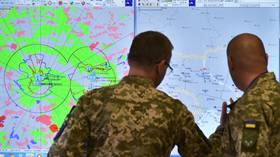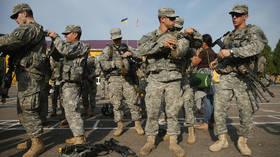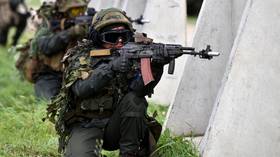NATO's mistake is that it still thinks it's dealing with the weakened Russia of the 1990s

Recent shockwaves in Russian-Ukrainian relations, and the increasing involvement of the US, could prove to be among the most significant milestones in the history of Europe since the end of the Cold War, over three decades ago.
But the groundwork for a clash of heads was laid long before the present day. Since the reunification of Germany, the continent’s security architecture – the careful truce between East and West that held strong even at the most tense moments of the 20th century – has been systematically dismantled.
Was that process avoidable? It’s pointless even to ask. What matters is that, since then, the key principle has been that each and every country can decide for itself which military and political alliances it wishes to join. Of course, that choice wasn’t always a free one and, after 1991, NATO became the only club in town as the others had all packed up.
NATO’s new problem
This, however, meant that the bloc itself fell into a trap. It underwent a series of seemingly trouble-free expansions, finding little or no opposition, as part of a political and ideological crusade. The military aspect came second, both in terms of how much new member states were actually supposed to contribute and whether the bloc would actually step in to defend them at all. Mutual support was there in theory, but nobody was anticipating starting a war with Russia or defending Slovakia or Latvia – this was viewed as an impossible scenario.
That is because, on one hand, there was this vague idea that Russia was part of some common security system with NATO – but nobody bothered to define what that meant in practical terms. The bloc preferred sticking to abstract political narratives, and members kept signing up. At the same time, in the first decade after the fall of the Soviet Union, Russia was so weak and so dependent on its foreign partners that even had it opposed NATO’s plans, it was widely believed it could be neutralized through non-military means. Rebuilding the country to the point of self-sufficiency, after all, would take years.
Well, years have gone by, but the West’s mindset hasn’t moved on. Given that narrative, any attempts by Russia to negotiate cast-iron guarantees about its security now or in the past could only have very limited success. All proposals made by Moscow, sincerely or otherwise, would require the other side giving up its underlying principle – that only NATO gets to make decisions. It can consider and ignore other parties’ interests at will, but they will always come second to its own goals. Anything else, for the bloc’s leaders, is unacceptable.
And let’s not forget the key mantra that dominated its thinking throughout the 1990s and the 2010s – no external player has the right to veto the alliance’s decisions on how it will choose to work with prospective members.
The standoff with Russia
In reality, there were of course certain limitations. In 2008, there was heated debate over the wording of NATO’s Bucharest Summit declaration, with France and Germany fending off US pressure to adopt a Membership Action Plan for both Georgia and Ukraine. Undoubtedly, the European arm of the bloc feared Moscow’s reaction. The compromise, brokered at the time, however, led to an even worse deadlock. The two countries neighboring Russia were promised they would eventually be admitted to NATO, but the door to them joining was left closed, with no explanation of what this really meant.
At the diplomatic level, the Kremlin was told this was just a declaration – nobody intended to let these countries join, it was just an act of politeness and everybody knew that. But this duplicity ensured military, political and diplomatic relations got stuck in quicksand, with the foundations of trust crumbling away. The overlaps between NATO and the EU complicated things still further. Despite being two different entities, they share almost identical memberships and have constructed a solid Euro-Atlantic framework. The post-Maidan clashes in 2014 erased the last remaining political borders between various European structures.
Already a murky situation, it has been exacerbated by internal processes happening in most EU states, as well as the US, Ukraine, and Russia. Politics could ruin the strategic calculations of the major players who think they understand the lay of the land and can skillfully get ahead in the game. This time around, with tensions flaring, all the big factions seem to be convinced it is their opponent who is trying to steal the lead, forcing them to react. Things are getting difficult and dangerous because there is no consensus over what is actually happening.
A dangerous new world
It has been 30 years since Russia entered a new era in its history and Moscow seemingly doesn’t want to maintain the old systems of sending signals to the West. It is seen as unproductive – something that makes the crisis worse. When President Vladimir Putin delivered his recent address at the Ministry of Foreign Affairs, he told the country’s top diplomat, Sergey Lavrov, to discuss the security guarantees his counterparts in other countries can provide, similar to the ones penned in the 2000s.
The idea is to abandon the principle that countries can choose their alliances as though it is nobody else’s business – which was never part of traditional geopolitics, but has become a given in recent decades. Well, this approach is no longer working. But creating a new one through political and diplomatic talks alone doesn’t seem feasible.
NATO’s defense guarantees, extended to its newer members as a hypothetical commitment, could become very real. And indeed, it is hard to imagine that the nightmarish scenarios crafted by the bloc’s junior partners to alarm their patrons could ever be proven right. They routinely insist that Putin wants to test the boundaries with NATO by attacking the Baltic states and Poland. In reality, Moscow seems to believe the bloc will honor its obligation more than those in Riga or Tallinn do – but when non-members, like Ukraine, start playing this game as well, the risk of a potential military conflict grows far higher.
The gambit that led to the 2008 war between Russia and Georgia could well be replicated. The absence of formal guarantees from NATO, but the constant presence of warm words, ideological assurances and even military support, creates a boundless ‘gray area.’ When Putin talks about maintaining “tension” with Ukraine, he means that Moscow must make it abundantly clear that stepping out into this gray area will have grave consequences.
This recent round of escalation in Eastern Europe showed that the old principles of security on the continent are no longer working. NATO expansion has created a new military and political landscape. Keeping things as they are could lead to new conflicts, while abandoning the belief that the bloc calls all the shots will require a drastic revision of all approaches. Russia will have to change the system and draw new “red lines.” We could, for example, redefine ‘Finlandization’ – the Cold War idea whereby countries retain their sovereignty but stay out of the geopolitical fray – as something positive. The term has become pejorative since then, but everything changes.
Think your friends would be interested? Share this story!
The statements, views and opinions expressed in this column are solely those of the author and do not necessarily represent those of RT.
The statements, views and opinions expressed in this column are solely those of the author and do not necessarily represent those of RT.














